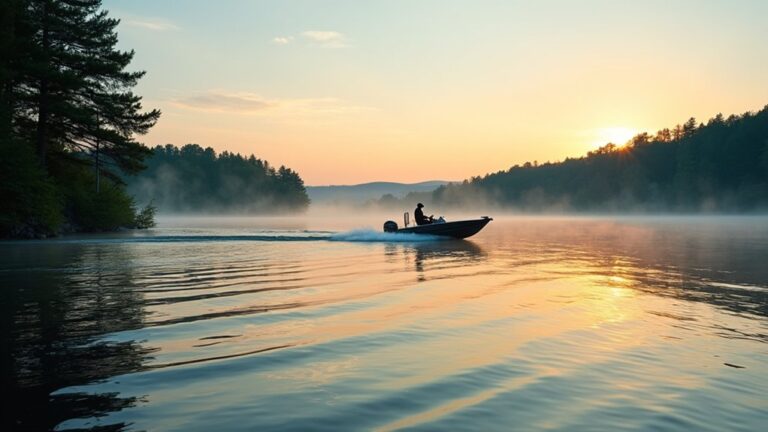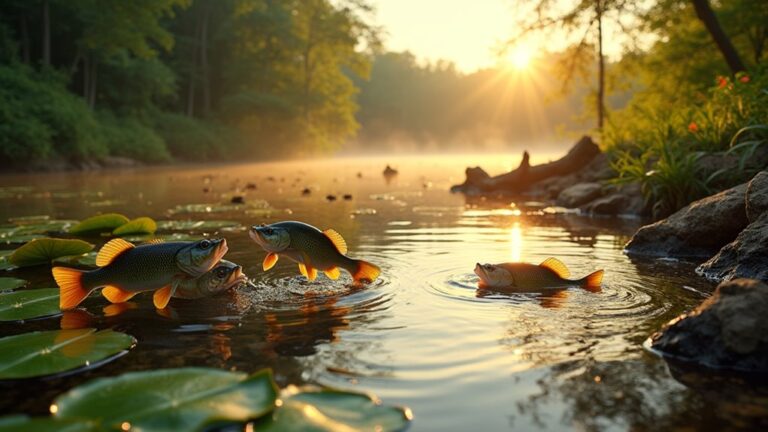Freshwater fishing is a thrilling experience, and you can catch your first fish with a few simple tips. Start by grabbing a reliable rod and reel, ideally a 66-inch spincast rod paired with a 150-size spinning reel. Use a 10 lb. monofilament line and hooks sized 6 to 10 to attract fish like bass. For bait, try live worms or minnows. Practice your casting technique for accuracy and aim for early mornings or late evenings for the best chance to reel in a catch. With these basics, you're on your way to becoming a pro at fishing! Discover more valuable insights next.
Key Takeaways
- Start with basic gear: a 66-inch spincast rod and 150-size spinning reel paired with 10 lb. monofilament line for versatility.
- Use live bait like worms and minnows to effectively attract a variety of fish species.
- Practice casting technique using a rubber weight to improve accuracy and control before fishing.
- Familiarize yourself with local fishing regulations and obtain the necessary license before heading out.
- Fish during early mornings or late evenings for the best chances of catching your first fish.
Understanding Fishing Basics
Understanding the basics of fishing can transform your experience on the water. With around 40 million participants in U.S. freshwater fishing, it's important to get familiar with key elements.
First, make certain you've got the right fishing gear. A reliable rod and reel are imperative, and you'll want to choose fishing lines with a line weight between 4 to 12 pounds, paired with hooks sized between 6 and 10.
Before you cast your line, check your local regulations. Most states require a fishing license, which can vary based on your age and location.
Proper casting techniques play a critical role in your success. Focus on body positioning and timing to improve your casting distance. When you feel a tug, it's time to set the hook—this is how you secure your catch.
Remember to follow responsible fishing practices, like catch-and-release and cleaning up after yourself, to protect fish populations and the environment.
These fishing tips won't only enhance your skills but also guarantee you enjoy your time on the water while contributing to sustainable fishing.
Essential Gear for Beginners
Choosing the right gear is vital for a successful fishing experience, especially for beginners. Start with a basic fishing rod and spinning reel combo, like a 66-inch spincast rod paired with a 150-size spinning reel. This setup simplifies your experience and makes it easier to learn the ropes.
Opt for a 10 lb. monofilament or nylon fishing line, as it provides versatility and is manageable for various freshwater species.
Next, gather some important tackle. You'll need different sizes of hooks, typically size 6-10, along with fishing weights and bobbers to signal fish activity. These items are critical for beginner fishing and will help you get started effectively.
When it comes to bait, live bait like worms and minnows is highly effective for attracting a range of freshwater fish species. This choice is especially beneficial for novice anglers looking to catch their first fish.
Techniques for Successful Casting
Once you've got your gear ready, mastering the techniques for successful casting is essential to your fishing success. Start by letting about six inches of line out of the rod tip. Position the reel below your dominant hand, ensuring the bail is flipped open before you cast. Hold the line with your finger to control the line release, which helps improve accuracy and distance.
For new anglers, practicing with a rubber weight instead of a hook can prevent injury and allow you to focus on your form. Use a smooth, controlled motion to throw the baited line, resembling the action of throwing a baseball. Timing is vital; release the line when your rod reaches a 10 o'clock position for ideal casting distance.
Remember to cast away from other anglers or obstacles to maintain safety and avoid tangling lines. Following these casting techniques can lead to good fishing experiences and help you become more confident in your skills.
With practice, you'll find the right rhythm and improve your casting technique, making your fishing trips more enjoyable and successful.
Choosing the Right Bait
Selecting the right bait is vital for a successful fishing trip, as it can greatly impact your chances of landing a catch. For beginners, using live bait like worms and minnows is highly effective, attracting a variety of fish species, including bass and panfish.
However, if live bait isn't available, you can opt for artificial lures such as soft stickbaits, crankbaits, or spinnerbaits, which mimic prey and can be just as effective.
When choosing your bait, consider your target species. Bass often prefer larger lures, while bluegill are typically caught with smaller offerings.
Additionally, using scented baits can enhance your fishing efforts, as the scent attracts fish from farther away, increasing your chances of a bite.
Before heading out, always check local regulations regarding bait types. Some areas restrict certain live bait species to protect local ecosystems, so it's important to follow these guidelines.
Conservation Practices to Follow
When you head out for a fishing trip, keeping conservation practices in mind is important for protecting aquatic ecosystems. One key practice is catch-and-release. If you catch undersized or unwanted fish, quickly return them to the water to increase their chances of survival and help maintain healthy fish populations.
Always handle fish with wet hands or gloves to protect their natural mucus layer, which is critical for their health. Use tools like pliers or dehookers to safely remove hooks, minimizing injury and ensuring a swift release.
After your fishing adventure, clean up by properly disposing of trash and avoiding the introduction of invasive species that can disrupt local ecosystems.
Educate yourself about local ecosystems and fishing regulations to promote sustainable practices. By understanding the impact of your actions, you can contribute to the preservation of our natural resources.
Finding Local Fishing Spots
Finding the right local fishing spots can greatly enhance your experience as a beginner angler. Knowing where to cast your line can make all the difference when you're out there for the first time.
Here are three effective ways to discover great locations:
- Consult Local Fishing Clubs: Local organizations can provide invaluable insights on accessible and popular freshwater fishing spots. They often have firsthand knowledge of the best times to fish and the species that are biting.
- Use Crowdsourced Apps: Apps like Fishbrain and FishAngler allow you to see fishing spots shared by other anglers. You'll find details on what fish usually get caught and the current fishing conditions, making it easier to plan your trip.
- Check State Wildlife Resources: State fishing agencies publish maps and guides that highlight public fishing areas. These resources help you identify the best places to fish, ensuring you have a productive outing with local tackle.
With these strategies, you'll be well on your way to finding the ideal fishing spots for your freshwater adventures.
Happy fishing!
Tips for a Great Experience
To make the most of your fishing experience, gear up with the right timing and location. Early mornings and late evenings are prime times for catching your first fish, as fish are more active during these periods.
Choose accessible spots like local lakes or ponds, where you're likely to find species such as bass and bluegill, making it easier to get started.
Use simple gear, like a spinning reel, which is perfect for all-purpose fishing and easy to manage. This way, you'll feel more confident and ready to catch.
Don't forget to familiarize yourself with local regulations, including fishing licenses and catch limits. This guarantees you're fishing responsibly and legally.
Additionally, pack everything you need for a comfortable outing. Bring along sunscreen, water, and snacks to stay hydrated and energized.
A well-prepared trip can make all the difference in your enjoyment. Remember, the goal is to have fun while learning the ropes of freshwater fishing.
With the right approach, you'll be well on your way to making great memories and hopefully landing that first catch!
Conclusion
Now that you're armed with the basics, crucial gear, and techniques, the thrill of your first catch is just around the corner. Picture the moment you feel that tug on your line—will it be a tiny sunfish or a feisty bass? Embrace the excitement and uncertainty that comes with each cast. Remember, every angler started just where you are. So grab your gear, find that perfect spot, and let the adventure unfold. What will you reel in today?




